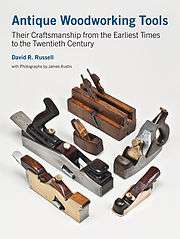Antique Woodworking Tools
|
Jacket with photograph by James Austin[1] | |
| Author |
David R. Russell assisted by Robert Lesage, with foreword by David Linley |
|---|---|
| Illustrator | James Austin |
| Cover artist | James Austin |
| Country | United Kingdom |
| Language | English |
Release number | 1st edition |
| Subject | Industrial archaeology, material culture |
| Genre | Reference |
| Published | Cambridge |
| Publisher |
John Adamson in association with Bernard J. Shapero |
Publication date | October 2010 |
| Pages | 528 |
| ISBN | 978-1-898565-05-5 |
| OCLC | 727125586 |
| 684.08207442783 | |
| LC Class | TT186 .R87 2010 |
| Website | www.antiquewoodworkingtools.co.uk |
Antique Woodworking Tools: Their Craftsmanship from Earliest Times to the Twentieth Century is David Russell's account of the history of woodworking tools illustrated profusely with items from his extensive collection of British, continental European and North American hand tools. Planes are given special attention and British makers, among them Holtzapffel, Norris, Mathieson and Spiers, are discussed in depth.
Summary
A wide array of edge and boring tools provides a broad survey of hand tool-making from prehistory to today. Writing in The Times, Huon Mallalieu encapsulated the function of the book: "Over the past 35 years [David Russell] has amassed probably the world’s largest collection of antique woodworking tools from the Stone Age to the 20th century ... The catalogue not only lists and lavishly illustrates 1556 items, but also makers’ stamps and associated material ..."[2]
Critical reception
The book has been widely acclaimed in both the general and specialized press. According to the Sheffield Telegraph, "the book not only celebrates the collection but is considered the most serious work of reference of its kind to date and destined to become a 'bible' in its field".[3] Looking at the book from another angle, Eve Kahn in the New York Times stated that the book was "intended to glamorize unsung innovations".[4] Carl Duguay, writing in Canadian Woodworking & Home Improvement, declared that the book was "Lavish, stunning, outstanding, magnificent ... superlatives just don't do justice to [it]."[5] The late Frank Ham, writing in the Australian journal Tool Chest, believed that the book was "the most impressive record of tools" he had ever seen.[6]
Focusing on the illustrations, Mark Bridge commented in Antiques Trade Gazette on how James Austin, the book's photographer, had "managed to capture the elusive qualities of balance, texture and patina which make the finest tools a pleasure to handle, frequently lifting them into the realm of folk art".[7]
Notes
- ↑ Clockwise from bottom left: adjustable shoulder plane serial no. 276 (Henley Optical Company); low-angle rebate/mitre plane with pin-and-hole adjustment (Norris); smoothing block plane in beech (Norris); moulding planes in beech (Norris); smoothing plane (Norris); A31 adjustable thumb plane in gun-metal (Norris).
- ↑ Huon Mallalieu, "The heft of a hammer, the balance of an axe or the certainty of a saw are the links between man and material", The Times, November 27, 2010.
- ↑ Sheffield Telegraph, December 9, 2010. See full article.
- ↑ Eve M. Kahn, "A Craftsman's Wares", New York Times, September 13, 2013, p. C26. See full article.
- ↑ Carl Duguay, "A 'must-have' for anyone who loves woodworking tools", Canadian Woodworking & Home Improvement See full article.
- ↑ Frank Ham, Tool Chest (Journal of the Hand Tool Preservation Association of Australia), no. 108, May, 2013.
- ↑ Mark Bridge, "The young apprentice cabinetmaker who became a connoisseur", Antiques Trade Gazette, October 22, 2011.
